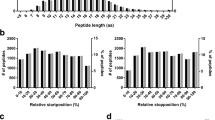Abstract
The peptide motif of the HLA-DR53 (DRB4*0101) molecule, which is associated with autoimmune diseases including Vogt-Koyanagi-Harada's syndrome, was determined by peptide binding assay using human L plastin p581–595 peptide and its substituted analogues. L plastin p581–595 peptide is one of the naturally processed peptides bound to HLA-DR9/DR53 (DRB1*0901/DRB4*0101) molecules. The binding affinity of each peptide to the HLA-DR53 molecule was measured by fluorescence intensity of biotinylate peptides to L cell transfectants expressing HLA-DR53 molecules, followed by treatment with avidin-fluorescence. Binding of biotinylated peptides to HLA-DR53 molecules was not inhibited by all single-alanine-substituted nonbiotinylated peptides, indicating that the replaced position was important for binding to the HLA-DR53 moleule. The inhibitory motif is considered to be an HLA-DR53-specific binding motif, composed of a positively charged residue (K) at position 1, a hydrophobic residue (I) at position 4, positively charged residue (R or K) at position 8 or 9, and another hydrophobic residue (I) at position 10. This predicted motif is different from the binding motifs of other HLA-DR molecules. binding peptides in combination with functional analyses, by alignment of sequenced endogeneous peptides, and by the use of an M13 display library (Rammensee et al. 1995; Hammer et al. 1993, 1992). No sequence information has been reported for naturally occurring HLA-DR53 (DRB4*0101)-associated peptides partly because their expression on the cell surface is relatively low for sequencing endogeneous self-peptides (Kinouchi et al. 1995). It has been shown that HLA-DR53 is positively associated with Vogt-Koyanagi-Harada's Syndrome in Japanese subjects (Moriuchi et al. 1979). The identification of a peptide motif for HLA-DR53 may help in understanding the mechanisms of this disease. We have previously reported that naturally processed peptides bound to HLA-DR9/DR53 molecules (Futaki et al. 1995). In this report, we determined the peptide which could bind to the HLA-DR53 molecule and we identified a putative HLA-DR53-specific binding motif by a peptide binding assay using L-cell transfectants expressing HLA-DR molecules.
Similar content being viewed by others
References
Brown, J. H., Jardetzky, T. S., Gorga, J.C., Stern, L. J., Urban, R. G., Strominger, J. L., and Wiley, D. C., Three-dimensional structure of the human class II histocompatibility antigen HLA-DR1.Nature 364: 33–39, 1993
Busch, R., Hill, C. M., Hayball, J. D., Lamb, J. R., and Rothbard J. B. Effect of natural polymorphism at residue 86 of the HLA-DR β chain on peptide binding.J Immunol 147: 1292–1298, 1991.
Chicz, R. M., Urban, R. G., Gorga, J. C., Vignali, D. A. A., Lane, W. S., and Stominger, J. L. Specificity and promiscuity among naturally processed peptides bound to HLA-DR allele.J Exp Med 178: 27–47, 1993.
Davenport, M. P., Quinn, C. L., Chicz, R. M., Green, B. N., Willis, A. C., Lane, W. S., Bell, J. I., and Hill, A. V. S.. Naturally processed peptides from two disease-resistance-associated HLA-DR13 aheles show related sequence motifs and the effects of the dimorphism at position 86 of the HLA-DRβ chain.Proc Natl Acad Sci USA 92: 6657–6571, 1995.
Dong, R.-P., Kamikawaji, N., Toida, N., Fujita, Y., Kimura, A., and Sasazuki, T. Characterization of T cell epitope restricted by HLA-DP9 is treptococcal M12 protein.J Immunol 154: 4536–4545.1995.
Futaki, G., Kobayashi, H., Sato, K., Taneichi, M., and Katagiri, M. Naturally processed HLA-DR9/DR53 (DRB1*0901/DRB4*0101)-bound peptides.Immunogenetics 42: 299–301, 1995
Hammer, J., Valsasnini, P., Tolba, K., Bolin, D., Higelin, J., Takacs, B., and Sinigaglia, F.. Promiscuous and allele-specific anchors in HLA-DR-binding peptides.Cell 74: 197–203, 1993
Hammer, J., Takacs, B., and Sinigaglia, F. Identification of a motif for HLA-DR1 binding peptides using M13 display libraries.J Exp Med 176: 1007–1013, 1992
Kamikawaji, N., Fujisawa, K., Yoshizawa, H., Fukunaga, M., Yasunami, M., Kimura, A., Nishimura, Y., and Sasazuki, T. HLA-DQ-restricted CD4+ T cells specific to streptococcal antigen present in low but not in high responders.J Immunol 146: 2560–2567, 1991
Kinouchi, R., and Katagiri, M. Analysis of naturally processed peptides bound to HLA-DR4, DR53 (DRB1*0405, DRB4*0101).Hokkaido J Med Sci 70: 175–181, 1995.
Moriuchi, J., Katagiri, M., Wakisaka, A., Ikeda, H., Maruyama, N., Tagawa, Y., Aizawa, M., and Itakura, K. Association of B-cell alloantigenic determinant, Hon 7, with Harada's disease.Immunogenetics 9: 487–489, 1979.
Mozes, E., Dayan, M., Zisman, E., Brocke, S., Licht, A., and Pecht, I. Direct binding of a myasthenia gravis related epitope to MHC class II molecules on living murine antigen-presenting cells.EMBO J 8: 4049–4052, 1989
Newcomb, J. R. and Cresswell, P. Characterization of endogeneous peptides bound to purified HLA-DR molecules and their absence from invariant chain-asociated α β dimers.J Immunol 150: 499–507, 1993
Rammensee, H.-G., Friede, T., Stevanović, S. MHC ligands and peptide motifs: first listing.Immunogenetics 41: 178–228, 1995
Rothbard, B. J., and Gefter, M. L. Interactions between immunogenic peptides and MHC proteins.Annu Rev Immunol 9: 527–565, 1991
Shackelford, D. A., Lampson, L. A., and Strominger, J. L.. Analysis of HLA-DR antigen by using monoclonal antibodies: recognition of conformational differences in biosynthetic intermediates.J Immunol 127: 1403–1410, 1981
Stern, L., Brown, J. H., Jardetzky, T. S., Gorga, J. C., Urban, R. G., Strominger, J. L., and Wiley, D. C. Crystal structure of the human class II MHC protein HLA-DR1 complexed with an influenza virus peptide.Nature 368: 215–221, 1994
Van der Burg, S. H., Ras, E., Drijhout, J. W., Benckhuijsen, W. E., Bremers, A. J. A., Melief, C. J. M., and Kast, W. M. An HLA class I peptide-binding assay based on competition for binding to class I molecules on intact human B cells.Hum Immunol 44: 189–198, 1995
Author information
Authors and Affiliations
Rights and permissions
About this article
Cite this article
Kobayashi, H., Kokubo, T., Abe, Y. et al. Analysis of anchor residues in a naturally processed HLA-DR53 ligand. Immunogenetics 44, 366–371 (1996). https://doi.org/10.1007/BF02602781
Received:
Revised:
Issue Date:
DOI: https://doi.org/10.1007/BF02602781




